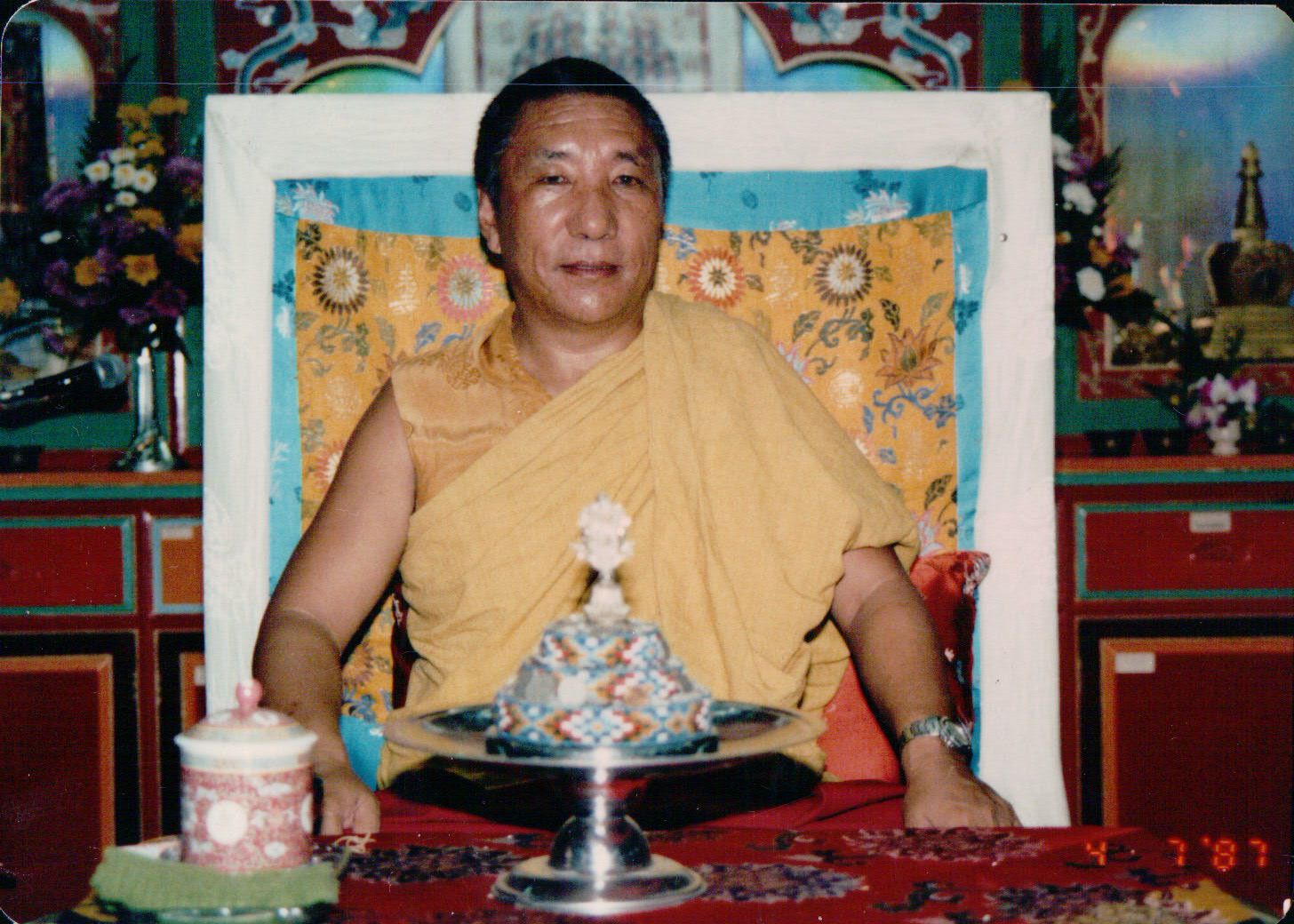 In Halscheid, Germany, in 1993, Rinpoche gave a word-by-word explanation on the beautiful praise to the Buddha, to Manjushri and the Guru, which he sings SO many times as the beginning of teachings. This praise is composed by Lodro Thaye and is found in the root text at the beginning of Treasury of Knowledge.
In Halscheid, Germany, in 1993, Rinpoche gave a word-by-word explanation on the beautiful praise to the Buddha, to Manjushri and the Guru, which he sings SO many times as the beginning of teachings. This praise is composed by Lodro Thaye and is found in the root text at the beginning of Treasury of Knowledge.
There is a study-group lead by Jim Scott that then goes through the verses translating each word.
Tibetan-English
To enroll in the course, the key is KTGR
 At Marpa House in Bouddha, Spring 1988, Rinpoche taught his students the Tibetan U-me alphabet.
At Marpa House in Bouddha, Spring 1988, Rinpoche taught his students the Tibetan U-me alphabet.
With the greatest of care, Ani Jampa meticulously wrote sentence after sentence on the blackboard, for students to copy.
Rinpoche would then come in and teach the subject: the chapters 1.1 and 6.2.
Tibetan only
5 talks, audio
To enroll in the course, the key is KTGR
 In Oregon 1991, Rinpoche explains the four conditions and six types of results to a few number of senior students.
In Oregon 1991, Rinpoche explains the four conditions and six types of results to a few number of senior students.
Tibetan only
1 talk, audio
To enroll in the course, the key is KTGR
 At Karma Chodrub Gyamtso Ling, Brussels, 27-30 May 1986, Rinpoche offers three talks on the Buddha's explanations on the eight consciousnesses, the three types of habitual tendencies and Dzogchen's three and six types of ignorance.
At Karma Chodrub Gyamtso Ling, Brussels, 27-30 May 1986, Rinpoche offers three talks on the Buddha's explanations on the eight consciousnesses, the three types of habitual tendencies and Dzogchen's three and six types of ignorance.
Visiting Oxford, 16-18 October 1987, Rinpoche briefly goes through the section of Treasury of Knowledge outlining how the delusions of samsara manifest and how they are freed. He continues with explanations on essential key-points of dharma: the necessity for turning the wheel of Dharma thrice, the path consisting in transformation of thoughts, the inherent subtle vajra body and how the tenets present the nature of mind. As always in Oxford, plenty of time is dedicated to questions.
Tibetan - French, Tibetan - English, Tibetan only
3 and 5 talks, audio
To enroll in the course, the key is KTGR
 At Kagyu Ling, Plaige April 1986, Rinpoche explains how the supreme nirmanakaya of the Buddha manifested in our world and performed the twelve deeds.
At Kagyu Ling, Plaige April 1986, Rinpoche explains how the supreme nirmanakaya of the Buddha manifested in our world and performed the twelve deeds.
Rinpoche's old friend and first translator, Acharya Tenpa Negi, is there and assists with the translation into English and there is a lot of warmth and laughter.
For the many other topics taught during the course, search "Plaige 1986" in the search box.
Tibetan / English
2 talks, audio
To enroll in the course, the key is KTGR
 In Bouddha, probably in 1995, Rinpoche teaches the third outline of the chapter, བསྟན་པ་དམ་པའི་ཆོས་རིམ་པར་ཕྱེ་བ།
In Bouddha, probably in 1995, Rinpoche teaches the third outline of the chapter, བསྟན་པ་དམ་པའི་ཆོས་རིམ་པར་ཕྱེ་བ།
The details of the settings for these talks are yet to be discovered, but they could be taught as preparation for translating the section.
Tibetan only
2 talks, audio
To enroll in the course, the key is KTGR
 Visiting Rigpe Dorje, San Antonio, November 1995, Rinpoche choses to offer:
Visiting Rigpe Dorje, San Antonio, November 1995, Rinpoche choses to offer:
- 4 talks with explanatory reading transmission for the booklet Selected Songs of Jetsün Milarepa
- 3 talks on the commentary to the Sutra of the Explication of the Definitive Meaning མདོ་སྡེ་དགོངས་པ་ངེས་པར་འགྲེལ་བའི་མདོའི་རྣམ་པར་བཤད་པ།
- 6 talks on TOK3.2: Cycles of Scriptural Transmission.
Rinpoche works with the songs from the booklet throughout the course.
Tibetan - English
6 talks, audio
To enroll in the course, the key is KTGR
 In Bouddha, most likely in the year 1995, Rinpoche elucidated to a small number of students the root text and excerpts from Lodrö Thaye's commentary presenting how the realized sangha gathered after the parinirvana of the Buddha and held three councils centered around how to safeguard and preserve the genuine dharma in the world for as long as possible for the benefit of all sentient beings.
In Bouddha, most likely in the year 1995, Rinpoche elucidated to a small number of students the root text and excerpts from Lodrö Thaye's commentary presenting how the realized sangha gathered after the parinirvana of the Buddha and held three councils centered around how to safeguard and preserve the genuine dharma in the world for as long as possible for the benefit of all sentient beings.
Tibetan only
4 talks, audio
To enroll in the course, the key is KTGR